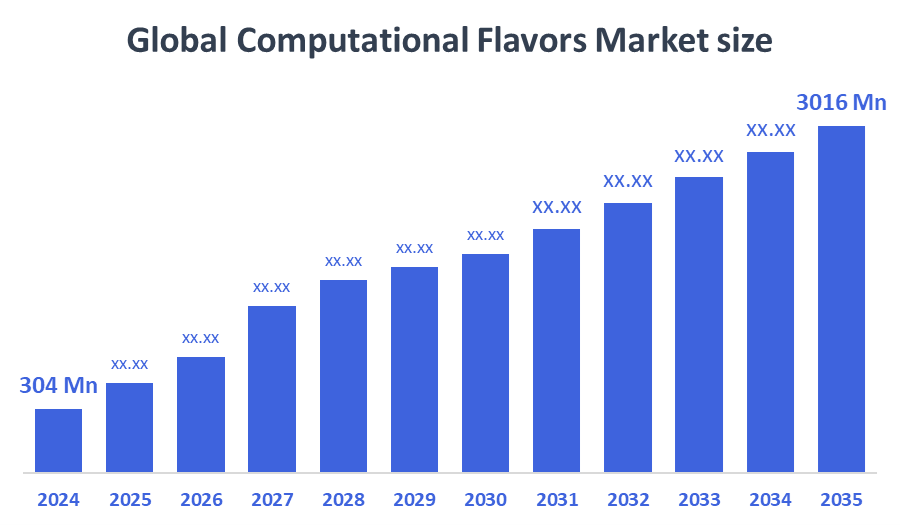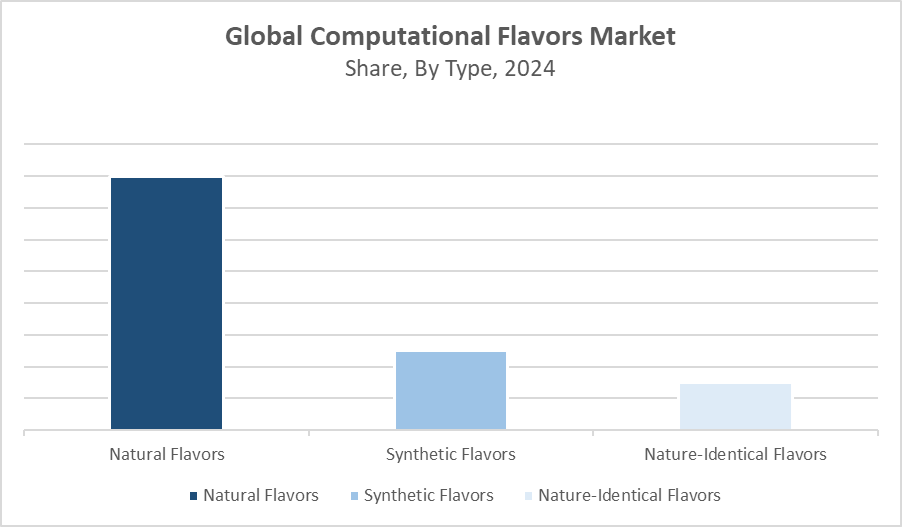Global Computational Flavors Market
Global Computational Flavors Market Size, Share, and COVID-19 Impact Analysis, Impact of Tariff and Trade War Analysis, By Type (Natural Flavors, Synthetic Flavors, and Nature-Identical Flavors), By Application (Beverages, Bakery & Confectionery, Dairy, and Savory Products), and By Region (North America, Europe, Asia-Pacific, Latin America, Middle East, and Africa), Analysis and Forecast 2025 - 2035
Report Overview
Table of Contents
Computational Flavors Market Summary, Size & Emerging Trends
According to Decision Advisor, The Global Computational Flavors Market Size is Expected to Grow from USD 304 Million in 2024 to USD 3016 Million by 2035, at a CAGR of 23.2% during the forecast period 2025-2035. The increasing demand for customised and sustainable flavor solutions in the food and beverage industry is a key factor driving market growth.

Key Market Insights
- North America is expected to hold the largest share in the computational flavors market during the forecast period.
- In terms of type, the natural flavors segment dominated in terms of revenue during the forecast period.
- In terms of application, the beverages segment accounted for the largest revenue share in the global computational flavors market during the forecast period.
Global Market Forecast and Revenue Outlook
- 2024 Market Size: USD 304 Million
- 2035 Projected Market Size: USD 3016 Million
- CAGR (2025-2035): 23.2%
- North America: Largest market in 2024
- Asia Pacific: Fastest growing market
Computational Flavors Market
The computational flavors market leverages advanced technologies like artificial intelligence and machine learning to design and optimize flavor profiles efficiently. This innovation speeds up flavor development, cuts costs, and improves accuracy and consistency, meeting the rising consumer demand for natural, clean-label, and innovative flavors in the food and beverage sector. Additionally, the use of predictive modelling supports sustainable production and waste reduction, further fueling market growth. Key benefiting industries include beverages, dairy, bakery, and savory foods, where there is an increasing preference for personalized and novel flavor experiences. Overall, computational flavors represent a transformative approach to flavor creation, combining technology and consumer trends to deliver tailored, high-quality products with greater efficiency.
Computational Flavors Market Trends
- Rising adoption of AI-driven flavor design tools by food manufacturers to meet personalized consumer preferences.
- Growing focus on natural and sustainable flavor compounds supported by computational screening.
- Integration of computational methods with sensory analysis for faster product development cycles.
Computational Flavors Market Dynamics
Driving Factors: Increasing demand for personalized and natural flavors
The increasing demand for personalised and natural flavors, combined with a growing focus on sustainability, propels the adoption of computational flavors. This technology enables rapid, cost-effective creation of customised flavour profiles, aligning with health-conscious and environmentally aware consumer preferences. Additionally, food manufacturers benefit from shorter product development cycles and enhanced flavor consistency. These advantages make computational flavor techniques highly attractive to companies seeking innovation and efficiency in flavor design.
Restrain Factors: Specialized expertise and significant investment in software and databases are necessary
High initial costs and complex data requirements limit widespread adoption of computational flavor technology. Specialized expertise and significant investment in software and databases are necessary, posing challenges for smaller businesses. Integrating diverse data sources and protecting intellectual property rights add further barriers. These hurdles slow market penetration, especially among companies with limited resources or technology access, restraining overall growth despite the technology’s potential benefits.
Opportunity: Developing economies with growing food and beverage industries
Emerging food sectors and expanding global markets present strong growth opportunities for computational flavors. Developing economies with growing food and beverage industries offer new demand streams. Collaborations between technology firms and flavor manufacturers encourage innovation and product diversification. The rising popularity of plant-based and functional foods creates additional avenues for computational flavor applications, allowing companies to meet evolving consumer preferences with novel and tailored flavor solutions.
Challenges: Protecting proprietary flavor formulas stored in digital platforms raises concerns over data security
Data privacy and regulatory compliance are key challenges in the computational flavors market. Protecting proprietary flavor formulas stored in digital platforms raises concerns over data security. Additionally, navigating diverse international regulations regarding flavor ingredients and labeling complicates product launches. Computational models must be adaptable to varying legal frameworks, requiring ongoing updates and compliance efforts, which increase operational complexity and risk in global commercialization.
Global Computational Flavors Market Ecosystem Analysis
The global computational flavors market ecosystem comprises software providers, flavor houses, food and beverage manufacturers, raw material suppliers, and regulatory bodies. Successful innovation relies on close collaboration between technology developers and flavor experts to create effective, tailored flavor solutions. Ensuring regulatory compliance and maintaining high-quality standards are essential for market acceptance and consumer trust. This interconnected ecosystem drives continuous development, supports product safety, and fosters confidence in computationally designed flavors across the food and beverage industry.
Global Computational Flavors Market, By Type
The natural flavors segment dominated the computational flavors market in terms of revenue, accounting for approximately 50% of the market share during the forecast period. This dominance is driven by the growing consumer preference for clean-label, natural, and minimally processed ingredients. Brands focus on using natural flavors to meet health-conscious and environmentally aware consumer demands, making this segment highly attractive and widely adopted.

The synthetic flavors segment holds a significant share of the market due to its cost-effectiveness and versatility across a broad range of food and beverage applications. These flavors offer manufacturers flexibility in formulation and consistent flavor profiles, making them a popular choice in large-scale production.
Global Computational Flavors Market, By Application
The beverages segment accounted for the largest revenue share in the computational flavors market, holding approximately 40%. This dominance is driven by the rising consumer demand for flavored beverages and functional drinks. Manufacturers are leveraging computational flavors to create unique, consistent, and health-conscious flavor profiles that cater to evolving tastes. The growing trend toward natural and clean-label ingredients in beverages further boosts this segment’s growth.
The bakery & confectionery segment represents a significant share of the market due to the increasing need for innovative and diverse flavor profiles. Computational flavor technology enables the development of unique and appealing flavors that enhance product differentiation. This segment benefits from continuous demand for novel tastes, helping brands attract and retain consumers in a competitive market.
North America commands the largest revenue share in the computational flavors market, accounting for approximately 35%.
This dominance is driven by the region’s early adoption of cutting-edge food technologies, extensive R&D investments, and a mature food and beverage industry. Leading flavor houses and innovative startups collaborate to develop personalized and sustainable flavor solutions. Consumers’ growing preference for natural, clean-label, and novel flavor experiences further propels market growth. Additionally, the strong presence of regulatory frameworks ensures high-quality standards, fostering consumer trust and market stability.
Asia Pacific is the fastest-growing region in the computational flavors market, projected to grow at a CAGR of around 8.5% during the forecast period.
This rapid growth is fueled by accelerating urbanization, increasing disposable incomes, and rising health and wellness awareness among consumers. Countries like China, India, and Japan are witnessing significant expansion in their food and beverage sectors, encouraging flavor innovation to meet diverse consumer demands. The region’s expanding e-commerce infrastructure and rising preference for plant-based and functional foods provide additional momentum for computational flavor adoption.
Europe holds a significant portion of the global computational flavors market,
supported by its stringent quality control regulations and strong flavor manufacturing capabilities. European consumers demand transparency, clean-label ingredients, and sustainable production methods, encouraging flavor houses to leverage computational technologies to meet these expectations. The presence of numerous well-established food and beverage companies and flavor innovators makes Europe a crucial hub for flavor development. Furthermore, compliance with rigorous regulatory standards ensures product safety and consistency, helping maintain steady market growth.
WORLDWIDE TOP KEY PLAYERS IN THE COMPUTATIONAL FLAVORS MARKET INCLUDE
- Givaudan
- Firmenich (DSM-Firmenich)
- International Flavors & Fragrances (IFF)
- Symrise
- MANE
- Takasago International Corporation
- Sensient Technologies
- Kerry Group
- Robertet
- T. Hasegawa
- Others
Market Segment
This study forecasts revenue at global, regional, and country levels from 2020 to 2035. Decision Advisor has segmented the computational flavors market based on the below-mentioned segments:
Global Computational Flavors Market, By Type
- Natural Flavors
- Synthetic Flavors
- Nature-Identical Flavors
Global Computational Flavors Market, By Application
- Beverages
- Bakery & Confectionery
- Dairy
- Savory Products
Global Computational Flavors Market, By Regional Analysis
- North America
- US
- Canada
- Mexico
- Europe
- Germany
- UK
- France
- Italy
- Spain
- Russia
- Rest of Europe
- Asia Pacific
- China
- Japan
- India
- South Korea
- Australia
- Rest of Asia Pacific
- South America
- Brazil
- Argentina
- Rest of South America
- Middle East & Africa
- UAE
- Saudi Arabia
- Qatar
- South Africa
- Rest of the Middle East & Africa
FAQs
Q. What is the expected market size of the global computational flavors market by 2035?
The global computational flavors market is projected to reach USD 3016 million by 2035.
Q. What is the compound annual growth rate (CAGR) for the computational flavors market from 2025 to 2035?
The market is expected to grow at a CAGR of 23.2% during the forecast period.
Q. Which region holds the largest share in the computational flavors market?
North America holds the largest share in the computational flavors market.
Q. Which type of computational flavor dominates the market?
The natural flavors segment dominates the market in terms of revenue.
Q. What are the main applications of computational flavors?
Key applications include beverages, bakery & confectionery, dairy, and savory products, with beverages leading in revenue share.
Q. What are the key driving factors for the growth of the computational flavors market?
Increasing demand for personalized and natural flavors, along with a growing focus on sustainability and rapid flavor development, are major drivers.
Q. What restrains the growth of the computational flavors market?
High initial investment, need for specialized expertise, complex data requirements, and intellectual property protection challenges limit widespread adoption.
Q. What opportunities exist in the computational flavors market?
Emerging food and beverage industries in developing economies present strong growth opportunities, along with the rising popularity of plant-based and functional foods.
Q. What are the challenges faced by the computational flavors market?
Data security concerns over proprietary formulas and navigating diverse international regulations are major challenges.
Q. Who are the key players in the global computational flavors market?
Key players include Givaudan, Firmenich (DSM-Firmenich), International Flavors & Fragrances (IFF), Symrise, MANE, Takasago International Corporation, Sensient Technologies, Kerry Group, Robertet, and T. Hasegawa.
Check Licence
Choose the plan that fits you best: Single User, Multi-User, or Enterprise solutions tailored for your needs.
We Have You Covered
- 24/7 Analyst Support
- Clients Across the Globe
- Tailored Insights
- Technology Tracking
- Competitive Intelligence
- Custom Research
- Syndicated Market Studies
- Market Overview
- Market Segmentation
- Growth Drivers
- Market Opportunities
- Regulatory Insights
- Innovation & Sustainability
Report Details
| Pages | 218 |
| Delivery | PDF & Excel via Email |
| Language | English |
| Release | Oct 2025 |
| Access | Download from this page |
